
Table of Contents
Understanding how long a concrete slab dry is essential for ensuring its structural integrity and long-term durability. The drying period typically ranges from 28 to 60 days, depending on factors such as water-to-cement ratio, mix design, slab thickness, and sub-base conditions. Environmental factors like temperature, humidity, and airflow play a critical role. Proper curing techniques ensure uniform moisture control, including methods like water, membrane, and steam. Ace Concrete Contractors Austin – Slabs, Driveways, Patios, and Sidewalks offer expert guidance and services to ensure that your concrete slab’s drying and curing process is optimized for durability and strength. Monitoring moisture levels with sensors and conducting regular tests are crucial to prevent surface cracking and delamination. Keep exploring for more detailed insights into how long concrete slabs dry and the factors influencing this process.
Key Takeaways
- Concrete slabs typically dry within 24 to 48 hours, enough to walk on, but complete curing can take up to 28 days.
- The water-to-cement ratio and mix design significantly affect how long a concrete slab takes to dry.
- Environmental factors like temperature, humidity, and airflow can extend or reduce concrete drying times.
- Proper curing techniques like water or membrane are crucial for optimal drying and strength.
- Moisture sensors and testing methods help ensure the concrete has dried sufficiently before further construction.
Concrete Curing Basics
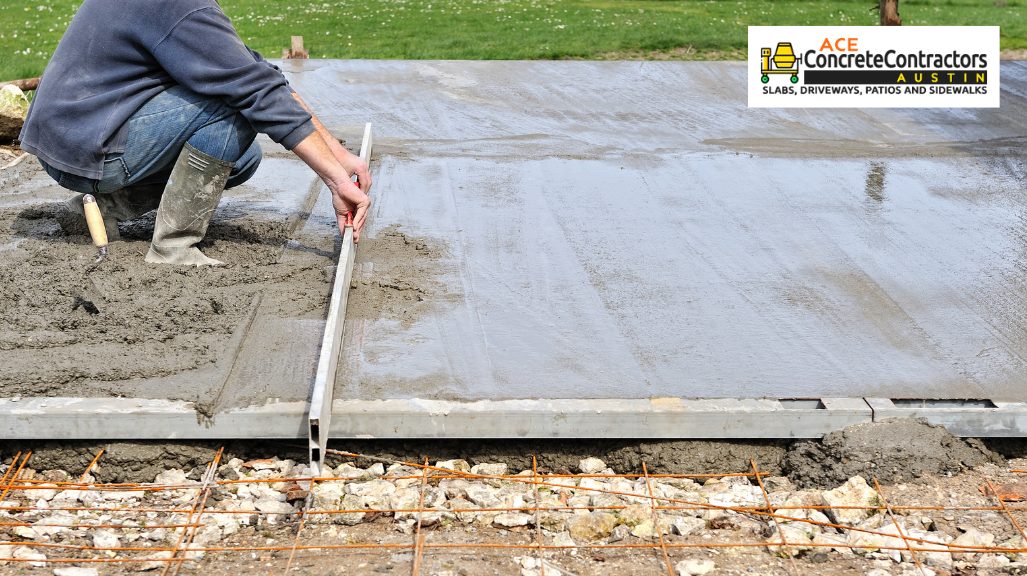
Concrete curing is essential to maintaining adequate moisture, temperature, and time to achieve the desired strength and durability. Proper curing techniques are vital to promote hydration, wherein the cement particles react with water to form a solid matrix. This matrix dramatically enhances the mechanical properties of the concrete, such as compressive strength and resistance to environmental factors.
There are several curing techniques employed in the industry to ensure ideal hydration. These include water curing, where the concrete surface is continuously wet, and membrane curing, which involves applying a sealant to retain moisture. Steam curing is often utilized in precast concrete operations to accelerate the strength gain by providing controlled heat and humidity. The hydration process is susceptible to variations in temperature and moisture levels. Therefore, maintaining a consistent and favorable curing environment is crucial for achieving the structural integrity of the concrete slab. Monitoring these parameters carefully ensures that the chemical reactions within the concrete proceed effectively, thereby enhancing its long-term performance. As construction community members, adhering to established curing protocols is essential for delivering high-quality, durable concrete structures. This shared commitment upholds the standards and reputation of the industry.
Importance of Drying Time
While proper curing techniques lay the foundation for concrete integrity, the significance of drying time cannot be overstated, as it directly impacts the slab’s final performance and durability. Adequate drying time guarantees that residual moisture within the slab is sufficiently reduced, minimizing the risk of complications such as surface cracking, delamination, and compromised structural integrity. Moisture control is crucial during this phase, as excessive moisture can lead to long-term issues, including mold growth, efflorescence, and compromised adhesion for subsequent surface treatments. The meticulous management of drying time is crucial for ideal surface preparation. Ensuring that the concrete has reached an appropriate level of dryness before applying floor coverings or sealants is essential to prevent future problems. Inadequate drying can lead to bubbles, blisters, and premature failure of applied materials, necessitating costly repairs and replacements. Concrete drying time is a complex yet essential element of the construction process, demanding precise attention to moisture control and surface preparation protocols. By prioritizing adequate drying time, professionals can enhance concrete structures’ longevity and effectiveness, ensuring they meet industry standards and client expectations for quality and reliability.
Factors Affecting Drying
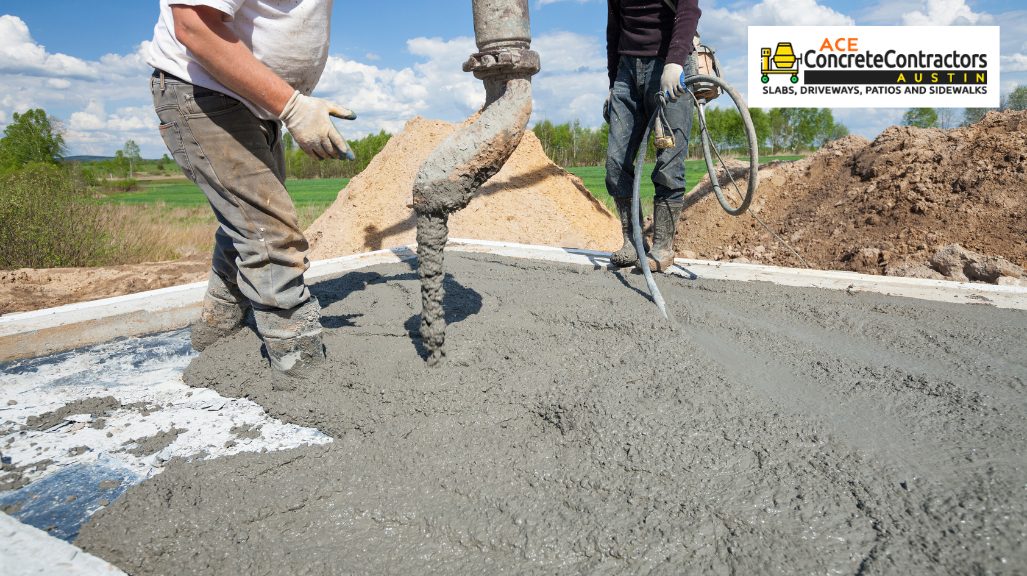
Understanding the factors affecting drying time is essential for optimizing concrete slab performance and ensuring long-term durability. One primary factor is the water-to-cement ratio, with higher water content extending the drying period.
Additionally, the concrete mix design, including the types and proportions of aggregates, plays a critical role in moisture evaporation rates. Surface sealants have a notable impact on the drying process. While sealants are designed to protect the surface, their application can hinder moisture escape, thereby prolonging the drying period. Contractors must carefully select and time the application of surface sealants to balance protection and drying efficiency.
Moreover, the slab thickness inherently affects drying time, with thicker slabs requiring more time for moisture to exit. Properly calibrated drying equipment, such as dehumidifiers and air movers, can expedite moisture removal, reducing drying time. Furthermore, the sub-base material and its moisture condition can impact the drying process. A wet sub-base can introduce additional moisture, potentially extending the drying duration. To mitigate this, employing vapor barriers beneath the slab can be beneficial.
Climate and Temperature
In addition to mixing design and surface treatments, environmental factors such as climate and temperature greatly influence the drying time of concrete slabs. Understanding the impact of climate patterns is essential for predicting and managing drying schedules. Regions with consistent weather conditions offer more predictable drying times, while areas experiencing significant temperature fluctuations can lead to inconsistent curing rates. Temperature plays a pivotal role in the hydration process of concrete. Elevated temperatures accelerate water evaporation from the concrete mix, potentially leading to rapid drying and an increased risk of cracking if not properly managed. Conversely, lower temperatures slow the hydration process, extending the overall drying period. Monitoring and adjusting curing practices based on real-time temperature data is essential to ensure ideal drying conditions. Furthermore, seasonal climate patterns can complicate drying timelines. For instance, summer heatwaves may require cooling techniques or modified curing compounds, whereas winter conditions might require additional heating measures to maintain appropriate curing temperatures.
Humidity Levels
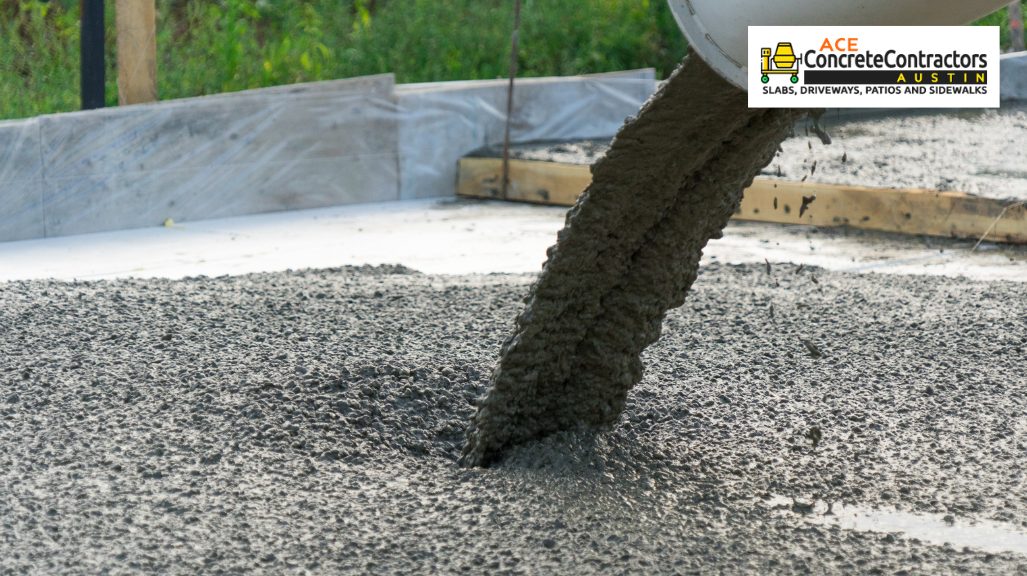
Humidity levels have a notable impact on the drying time of a concrete slab, as high humidity can hinder moisture evaporation. Maintaining an ambient relative humidity range of 40% to 60% is advised for ideal results. This controlled environment guarantees efficient hydration and curing processes, ultimately enhancing the structural integrity of the concrete.
Impact on Drying Time
Ambient humidity levels significantly influence the drying time of concrete slabs, impacting the rate of moisture evaporation from the surface. High humidity levels slow the evaporation process, prolonging the drying period and delaying project timelines. This environmental impact necessitates careful planning and scheduling within the construction industry to mitigate potential delays and associated costs.
Elevated humidity can also increase the risk of surface imperfections, such as efflorescence or mold growth, necessitating additional remedial work. These factors contribute to higher construction costs as extra labor, materials, and time are required to address these issues.
Conversely, low humidity can accelerate drying times and induce rapid surface drying, leading to potential cracking and compromised structural integrity if not correctly managed. Incorporating humidity control measures, such as dehumidification systems or moisture barriers, can optimize the drying environment and guarantee consistent results. Monitoring ambient humidity levels and adjusting project schedules can greatly enhance project efficiency and quality.
Optimal Humidity Range
Achieving the ideal humidity range is essential for guaranteeing proper concrete slab drying, as it directly impacts the hydration process and overall structural integrity. Concrete drying is a sophisticated process that demands careful monitoring of environmental conditions, particularly humidity levels. For best results, maintaining a balanced humidity range is paramount. Utilizing moisture meters and dehumidification methods is vital to achieve this equilibrium.
To effectively manage humidity levels, consider the following guidelines:
Relative Humidity (RH) Maintenance: Aim for an RH level between 40% and 60%. This range promotes adequate moisture evaporation without compromising the curing process.
Moisture Meters Usage: Employ high-precision moisture meters to track the concrete’s internal moisture content. These instruments provide real-time data, facilitating timely adjustments to environmental controls.
Dehumidification Methods: Advanced dehumidification methods, such as desiccant dehumidifiers or mechanical dehumidifiers, must be implemented to control ambient humidity. These systems help sustain the ideal conditions, preventing excessive moisture accumulation.
Adhering to these practices accelerates the drying process and ensures the concrete slab reaches its intended strength and durability. By fostering a collaborative approach and sharing best practices, industry professionals can collectively achieve superior outcomes in concrete slab drying.
Slab Thickness
The thickness of a concrete slab greatly influences the duration required for it to reach an acceptable moisture level for further construction activities. Typically, a thicker slab retains moisture longer, necessitating an extended drying period. For instance, a 4-inch slab generally requires approximately 30 to 90 days to dry, whereas a 6-inch slab may need up to 180 days, depending on environmental conditions. Slab reinforcement and slab insulation also play pivotal roles in this timeline. Reinforcement with steel bars or mesh can create denser concrete, potentially prolonging the drying process. Additionally, the integration of slab insulation, often used to enhance thermal performance, can impede moisture evaporation by creating a barrier, thereby extending the duration required for the slab to reach a stable moisture level. Understanding the interplay between slab thickness, reinforcement, and insulation is essential for effectively planning construction schedules. Industry professionals must account for these factors to optimize project timelines and promote structural integrity
Explore More Topics: 6 Most Common Concrete Sidewalk Issues
Mix Design Impact
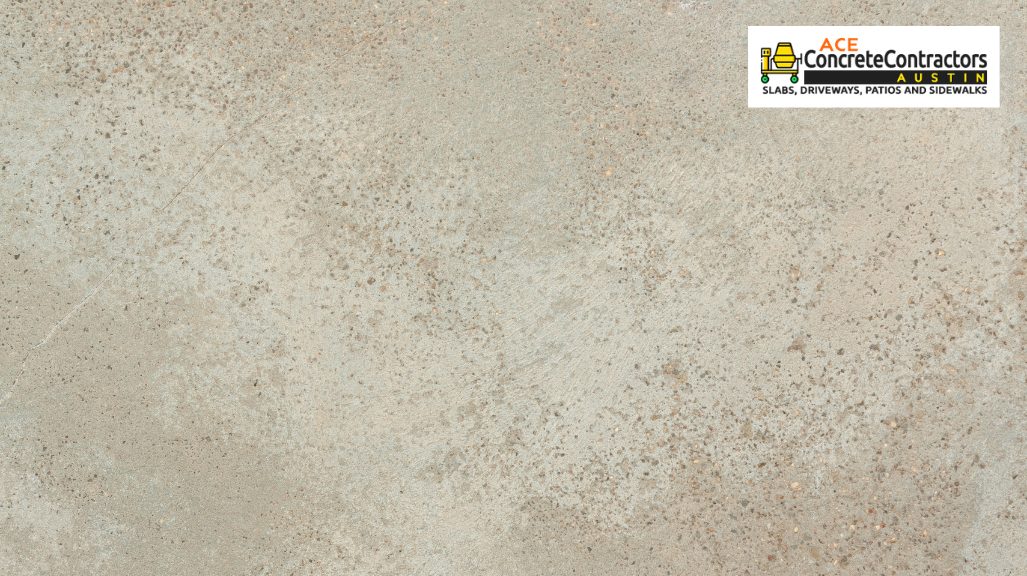
The mix design also plays a crucial role in the drying time of a concrete slab, and it is primarily influenced by the water-cement ratio. Moreover, the aggregate size can alter the moisture retention properties, impacting the drying duration. In addition, adding admixtures can modify the hydration process and consequently affect the time required for the slab to reach the desired moisture level.
Water-Cement Ratio
The water-cement ratio is a critical factor affecting concrete slab drying time, which directly influences the mix design and subsequent hydration process. The water-cement ratio determines the balance between workability and strength in the concrete mix. Lower water-cement ratios generally enhance strength but can complicate workability and increase the risk of shrinkage cracks, whereas higher ratios facilitate easier handling but may compromise structural integrity.
In concrete technology, the water-cement ratio is pivotal for the following reasons:
Hydration Process: The hydration process, wherein cement reacts with water to form a complex matrix, is sensitive to the amount of water present. Insufficient water can impede complete hydration, while excess water can prolong drying times and weaken the concrete.
Shrinkage Cracks: High water-cement ratios can lead to significant shrinkage as the excess water evaporates, increasing the likelihood of shrinkage cracks. This can affect the durability and aesthetic quality of the finished slab.
Drying Time: The ratio directly impacts drying time. Lower ratios generally result in faster drying, but balancing this with adequate hydration and minimal cracking is essential.
Professionals in the field must meticulously calibrate the water-cement ratio to ensure optimal performance and longevity of concrete slabs.
Aggregate Size Effects
Aggregate size dramatically influences the concrete mix design, affecting the slab’s mechanical properties and drying behavior. Larger aggregates reduce the overall surface area that must be coated with cement paste, which can decrease water demand and potentially reduce drying time. Conversely, smaller aggregates increase the surface area, requiring more cement paste and water, prolonging the drying process.
The shape of the aggregate also plays an important role. Angular aggregates, often derived from crushed stone, provide better interlock and higher mechanical strength than rounded aggregates, typically sourced from riverbeds.
However, the increased surface area of angular aggregates can elevate water requirements, impacting the drying time.
Furthermore, the aggregate source can introduce variability in the drying behavior. Natural aggregates from riverbeds or quarries may contain varying moisture levels, affecting the initial water-cement ratio and subsequent drying time.
Careful selection and testing of aggregates are vital to ensure consistent performance and predictable drying times.
Admixtures Influence
Incorporating admixtures into the concrete mix design can significantly change the slab’s drying time and mechanical properties. Admixtures are added to alter the chemical composition of the concrete, thereby affecting its hydration process and subsequent drying rate.
Drying Accelerants: These admixtures, also known as accelerators, expedite the hydration process, allowing the concrete to gain strength more quickly and reducing the overall drying time. They are instrumental in cold conditions where curing times are naturally extended.
Water-Reducing Admixtures: By reducing the water-to-cement ratio, these admixtures enhance the workability of the concrete without compromising its strength. This leads to a denser mix, which can influence the drying time by reducing the amount of free water that needs to evaporate.
Retarders: On the contrary, retarders slow the hydration process, extending the drying time. These are often used in hot weather conditions to prevent premature setting and maintain a uniform curing process.
These admixtures must be carefully proportioned to achieve the desired balance between drying time and mechanical performance. Understanding the specific chemical composition of each admixture and its interaction with the mix design is essential for optimizing the drying time of concrete slabs.
Water-Cement Ratio
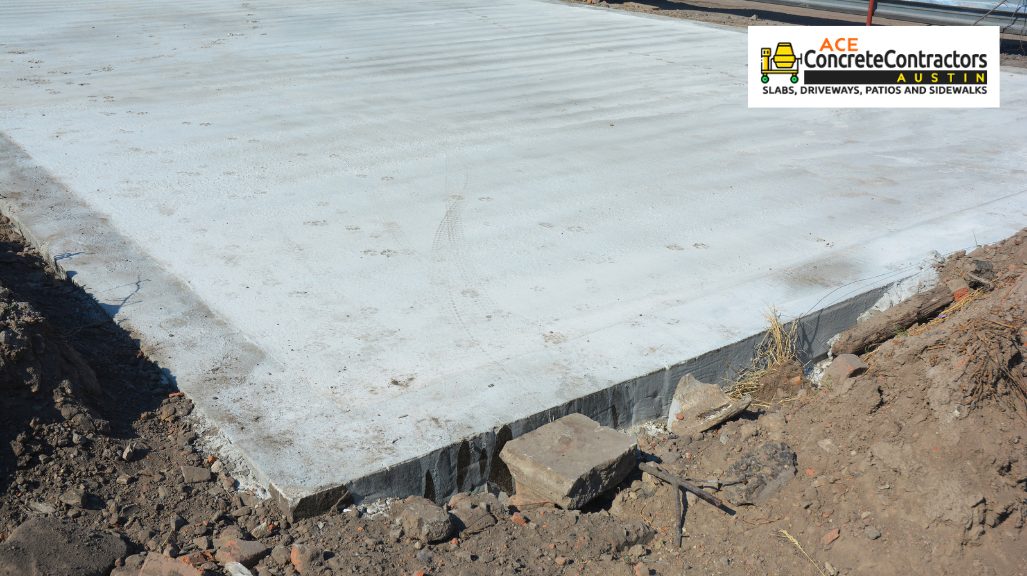
The water-cement ratio is a critical factor that directly influences a concrete slab’s strength, durability, and drying time. This ratio, defined as the weight of water to the weight of cement used in a concrete mix, dictates the hydration process, which is essential for concrete to achieve its desired properties.
During hydration, water chemically reacts with cement to form calcium silicate hydrate (C-S-H), the compound responsible for the concrete’s strength. However, excess water can lead to higher water absorption rates, resulting in a weaker, more porous structure.
A lower water-cement ratio generally produces concrete with increased strength and reduced permeability, enhancing its durability. Conversely, a higher water-cement ratio can expedite the drying process but at the expense of compromising structural integrity and longevity. The ideal water-cement ratio balances the need for workability during placement with the long-term performance of the slab.
Maintaining precise control over the water-cement ratio is paramount for industry professionals aiming to achieve optimal concrete performance. This ensures that the concrete slab meets the immediate construction requirements and stands the test of time, providing reliability and robustness.
Surface Moisture
How does surface moisture influence a concrete slab’s drying time and overall quality?
Surface moisture plays a critical role in both the drying process and the resultant integrity of the slab. It impacts the rate at which moisture evaporates from the concrete surface, affecting the timeline for subsequent construction activities.
Moisture Sensors:
Utilizing moisture sensors enables precise monitoring of surface moisture levels, guaranteeing that the drying process is carefully controlled. These instruments provide essential real-time data that help adjust environmental factors such as humidity and temperature.
Surface Tension:
The surface tension of the concrete mix’s water influences the slab’s capillary action. Higher surface tension can slow the moisture evaporation rate, extending the drying period. Conversely, lower surface tension can expedite drying but may cause issues like cracking.
Quality Assurance:
Managing surface moisture is crucial for quality assurance. Properly controlled surface moisture ensures the concrete slab’s strength and durability. Insufficient drying can lead to problems such as efflorescence and compromised structural integrity. For concrete industry professionals, understanding and controlling surface moisture using advanced techniques and tools is essential for achieving high-quality, long-lasting concrete slabs.
Testing Dryness
Accurately testing the dryness of a concrete slab is crucial for determining its readiness for subsequent construction phases and guaranteeing structural integrity. The two primary methods employed in the industry are moisture meters and the calcium chloride test. These techniques offer precise measurements, thereby enabling professionals to make well-informed decisions.
Method | Process Overview |
Moisture Meters | Measure moisture content within the slab using electrical resistance or capacitance. This method provides immediate results and is non-destructive. |
Calcium Chloride | It involves placing a sealed container of calcium chloride on the slab surface. The container absorbs moisture over a specified period, typically 60-72 hours, and is weighed to determine the moisture emission rate. |
Moisture meters are favored for their rapid feedback and ease of use. However, the calcium chloride test is often seen as more dependable for verifying long-term moisture emission rates, making it invaluable for critical applications such as flooring installations. Each method has advantages and limitations, necessitating a thorough approach to testing.
Employing these testing methodologies ensures that the slab meets industry standards for dryness, thereby mitigating potential risks such as mold growth, adhesive failures, and compromised structural integrity. Through systematic testing, professionals can ensure the quality and durability of their projects.
Drying Time Guidelines
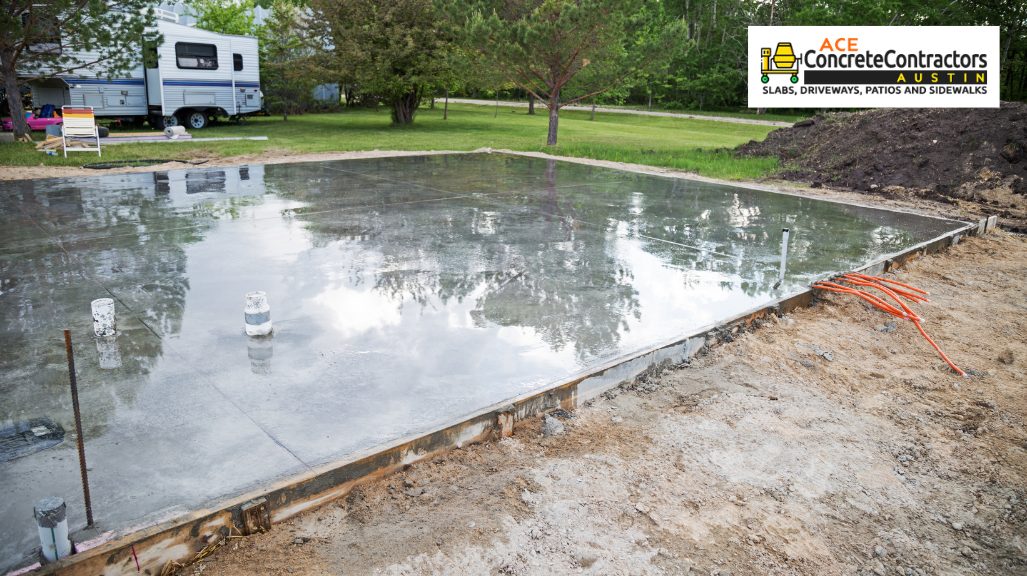
Drying time for concrete slabs is influenced by various factors, including slab thickness, ambient humidity, and temperature. Understanding these factors and maintaining ideal drying conditions are essential for achieving the desired moisture levels. This section outlines key considerations and industry standards to guarantee effective and efficient drying processes.
Factors Affecting Dry Time
Several critical factors influence the drying time of a concrete slab, each playing a significant role in the overall curing process. Understanding these factors is essential for professionals aiming to achieve the best results.
- Moisture Barriers: Moisture barriers beneath the slab can dramatically affect drying time. These barriers prevent moisture from seeping into the concrete, promoting faster drying by limiting the amount of water that evaporates from the mix.
- Concrete Porosity: The porosity of the concrete mix directly impacts the drying time. Higher porosity means more excellent water absorption and increased evaporation time. Selecting the appropriate mix design with controlled porosity levels is essential for managing drying schedules and ensuring structural integrity.
- Slab Thickness: The thickness of the concrete slab is another critical factor. Thicker slabs contain more water and require a more extended period for moisture to dissipate evenly throughout the material. Standard industry practice demands precise calculations for slab thickness, ensuring that the drying time aligns with project timelines and quality standards.
Optimal Drying Conditions
To achieve ideal drying conditions for concrete slabs, adhering to industry-standard drying time guidelines, which consider environmental factors such as humidity, temperature, and airflow, is imperative. Proper ventilation techniques are essential in managing these conditions effectively. Implementing mechanical ventilation systems can significantly enhance airflow, expediting moisture evaporation from the slab’s surface.
Additionally, dehumidifiers can help regulate humidity levels, ensuring the environment is conducive to best drying. Temperature control is another pivotal factor. Maintaining a consistent temperature within the range recommended by industry standards—typically between 50°F and 90°F—promotes uniform curing and minimizes the risk of thermal cracking. Insulation materials play a critical role in this aspect, as they help stabilize the temperature by reducing external thermal fluctuations.
Moreover, monitoring the drying progress using precise measurement tools such as moisture meters is essential. This methodical approach allows for timely adjustments to the drying environment, ensuring adherence to the specified guidelines. By effectively combining ventilation techniques, temperature control, and insulation materials, professionals can achieve top drying conditions that facilitate the concrete slab’s intended performance and longevity.
Accelerating Curing
Employing various methods to accelerate the concrete curing process can significantly reduce the time required for a slab to reach its peak strength. One highly effective technique is steam curing. This method leverages high-temperature steam to enhance hydration, notably shortening the time needed for the concrete to gain strength. Steam curing is particularly advantageous in colder climates where traditional curing may be less effective.
Another widely utilized strategy involves applying curing compounds. These chemical agents form a membrane on the surface of the concrete, minimizing moisture loss and ensuring a more efficient curing process. Curing compounds can be especially useful in large-scale projects where consistent hydration across the slab is critical.
Here are three commonly implemented methods to accelerate curing:
- Steam Curing: Utilizes high-temperature steam for rapid strength gain.
- Curing Compounds: Chemical agents that create a moisture-retaining membrane.
- Accelerators: Additives mixed into the concrete to speed up hydration.
Each of these techniques offers unique benefits and can be selected based on the project’s specific needs. By incorporating these methods, professionals can achieve faster turnaround times while maintaining the structural integrity and durability of the concrete slab.
Common Mistakes
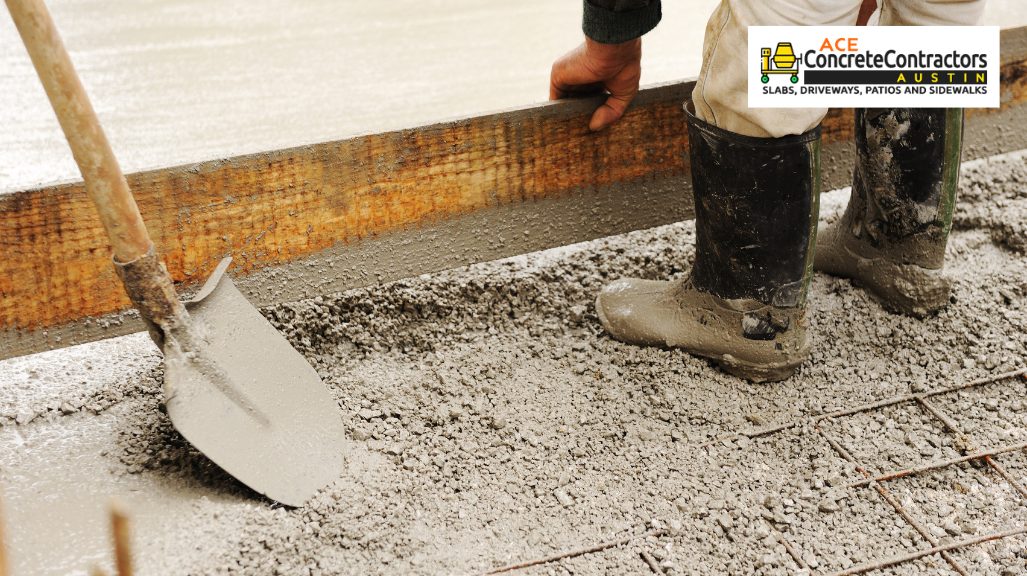
Several common mistakes can significantly impede ensuring ideal drying times for concrete slabs. Incorrect water ratio, poor curing practices, and neglecting weather conditions are frequent errors that can compromise the structural integrity and longevity of the slab. Addressing these issues and adhering to industry standards are critical for achieving the desired results.
Incorrect Water Ratio
An incorrect water-to-cement ratio is one of the most frequent mistakes that can lead to extended drying times and compromised structural integrity of concrete slabs. This issue typically arises due to a need to understand the precise balance between water and cement to achieve the best results.
Over-watering the mix can result in several detrimental outcomes:
- Extended Drying Times: Excess water in the mix increases the overall drying time, which can delay project timelines and affect the application of subsequent finishes.
- Reduced Strength: Too much water dilutes the cement paste, leading to a weaker concrete structure that fails to meet the necessary load-bearing requirements.
- Increased Porosity: An improper mix can create a porous concrete surface, making it more susceptible to water penetration, undermining moisture barriers, and reducing the effectiveness of curing agents.
Properly managing the water-to-cement ratio is essential for ensuring the durability and performance of concrete slabs. You can avoid these pitfalls by adhering to industry standards and employing precise measurement techniques.
Utilizing moisture barriers and effective curing agents can further enhance the drying process and structural integrity, ensuring the concrete meets the specifications and longevity expectations.
Poor Curing Practices
Improper curing practices can significantly affect concrete slabs’ drying time and structural integrity, leading to potential failures and costly repairs. One common mistake involves improper insulation during the curing process. Adequate insulation is critical to maintaining consistent moisture levels and temperature, essential for proper hydration and strength development. Insufficient or uneven insulation can result in differential curing rates, causing internal stresses and cracking.
Another prevalent issue is unsealed edges. Unsealed edges allow moisture to escape prematurely from the concrete slab, disrupting the curing process. This premature moisture loss can lead to shrinkage, surface crusting, and a weakened slab structure. Ensuring that edges are properly sealed can mitigate these risks by maintaining the necessary moisture levels throughout the slab’s curing period. Using industry-recommended curing compounds and techniques, such as wet curing, plastic sheeting, or blankets, can significantly enhance the curing process. Professionals in the field understand that neglecting these critical aspects compromises the slab’s performance and diminishes the sense of craftsmanship and pride associated with high-quality concrete work. Proper curing practices are, thus, indispensable for achieving durable, long-lasting concrete slabs.
Ignoring Weather Conditions
It is essential to account for weather conditions during the curing process to ensure the drying time and overall quality of concrete slabs. Weather variables such as temperature, humidity, and wind speed greatly influence the effectiveness of curing techniques and, consequently, the strength of concrete.
- Temperature Fluctuations: Extreme temperatures can either accelerate or decelerate the curing process, leading to inadequate hydration and compromised concrete strength. High temperatures increase the rate of water evaporation, while low temperatures slow down the chemical reactions essential for curing.
- Humidity Levels: High humidity can prolong drying, whereas low humidity can cause rapid moisture loss. Both conditions necessitate adjustments in curing techniques to maintain ideal moisture levels within the slab, ensuring uniform strength development.
- Wind Speed: High wind speeds can exacerbate water evaporation from the concrete surface, leading to premature drying and potential cracking. Effective curing techniques, such as windbreaks or curing compounds, are crucial to mitigate these effects.
Long-Term Effects

The long-term effects of concrete slab drying encompass structural integrity, potential for cracking, and overall durability. One significant concern is shrinkage cracking, which can arise when moisture evaporates rapidly from the slab. This phenomenon leads to dimensional changes, inducing internal stresses that result in cracks. Surface scaling is another critical issue, where the slab’s surface layer peels away due to freeze-thaw cycles or improper curing, compromising its durability.
Phase of Drying | Long-Term Impact |
Initial Drying | Shrinkage Cracking |
Intermediate | Differential Settlement |
Final Drying | Surface Scaling |
Post-Drying | Reduced Load Capacity |
Ongoing Exposure | Environmental Degradation |
Differential settlement can occur as concrete slabs dry over time, leading to uneven surfaces and potential tripping hazards. In the final drying stages, surface scaling becomes more pronounced, especially in climates with pronounced temperature fluctuations. Post-drying, reduced load capacity is a pressing concern as the concrete’s ability to bear weight diminishes.
The ongoing exposure to environmental factors such as moisture, chemicals, and temperature changes can exacerbate degradation, making it crucial for professionals to account for these variables during construction and maintenance. Understanding these long-term effects ensures the longevity and resilience of concrete structures, fostering a sense of reliability and belonging within the industry.
Professional Advice
Ensuring ideal concrete slab drying requires adherence to best practices in curing methods, moisture control, and environmental protection. Properly executed, these practices guarantee that the slab design maintains structural integrity and enhances concrete aesthetics.
Here are three essential steps to achieve peak drying:
- Curing Methods: Implementing effective curing methods is pivotal. Techniques such as water, membrane, and steam curing help maintain appropriate moisture levels within the slab. This ensures the gradual and uniform hydration of cement particles, which is vital for achieving the desired strength and durability.
- Moisture Control: Monitoring and controlling moisture levels during the drying phase is essential. Utilizing moisture barriers and vapor retarders can prevent external water ingress and internal moisture escape. This helps maintain consistent drying conditions, reducing the risk of cracking and other defects.
- Environmental Protection: Protecting the concrete slab from extreme environmental conditions, such as excessive heat, cold, or wind, is crucial. Employing windbreaks, shades, and thermal blankets can safeguard the slab against rapid moisture loss, which can compromise both slab design and concrete aesthetics.
Frequently Asked Questions
Can Concrete Slabs Dry Faster in Direct Sunlight?
Sun exposure can accelerate the drying process of concrete slabs by increasing evaporation rates. However, achieving the best results often requires drying accelerants and chemical additives that speed up hydration. It is essential to balance these factors to avoid cracking or reduced durability. Industry professionals should consider environmental conditions, proper curing practices, and the specific composition of the concrete mix for top outcomes.
How Does Foot Traffic Affect Concrete Slab Drying Time?
Foot traffic can significantly impact the moisture evaporation process of a concrete slab. The influence of footwear can cause surface deformations, which may impede the uniform evaporation of moisture. This non-uniform drying can lead to potential weaknesses and irregularities in the slab’s structural integrity. As a result, it is essential to limit foot traffic during the initial curing period to promote ideal drying conditions and maintain structural soundness.
Are There Specific Tools to Measure Concrete Slab Dryness?
Industry professionals use specific tools such as moisture meters and relative humidity sensors to measure concrete slab dryness accurately. Moisture meters provide direct readings of the surface moisture content, while relative humidity sensors measure the ambient humidity levels within the slab. Employing these instruments guarantees precise monitoring and adherence to industry standards, fostering a sense of expertise and belonging among professionals dedicated to achieving ideal concrete curing conditions.
What Are Signs of Insufficiently Dried Concrete Slabs?
Signs of insufficiently dried concrete slabs include persistent moisture retention, which can lead to structural issues. Surface discoloration often indicates trapped moisture beneath the slab. A professional assessment might reveal elevated moisture levels using tools such as a calcium chloride test or a relative humidity probe.
Ensuring proper curing and drying times is critical to maintaining concrete installations’ structural integrity and aesthetic quality.
Can Painting or Sealing Be Done Before the Slab Is Fully Dry?
Painting or sealing a concrete slab before it is scorched can lead to significant issues due to moisture retention. Proper curing methods are crucial to guarantee that the slab reaches peak strength and durability. Premature coatings application can trap moisture, causing adhesive failures or surface defects. Therefore, industry best practices recommend waiting until the slab is fully cured to avoid compromising the structural integrity and appearance of the concrete.
Conclusion
The drying time of a concrete slab is a critical factor influenced by various parameters, including climate, temperature, and humidity levels.
Proper curing is essential to achieve peak strength and durability. Accelerating methods should be employed judiciously to avoid compromising structural integrity. Common mistakes can lead to long-term detrimental effects. Adherence to professional guidelines and standards guarantees the longevity and performance of the concrete slab.
